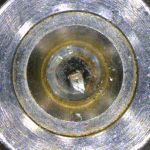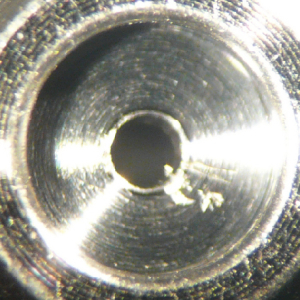TYPICAL WATERJET ORIFICE FAILURE MODES
ORIFICE FAILURE MODES
The #1 Failure Mode, encompassing 99% of all synthetic corundum orifice failure, is attributed to PARTICLE IMPACT.
FAILURE DUE TO PARTICLE IMPACT
- Failure from debris from the material being cut, which has been sucked through the orifice in the vacuum created when turning the jet off.
- Failure from metal or plastic particles from high pressure tubing and filters.
- Failure from garnet particles pulled back through the jewel’s orifice via the vacuum created when the stream is cycled off.
- Failure from high pressure seal particles.
- Failure from other line-borne contaminants.




THE EFFECTS OF CUTTING WITH A DEFECTIVE ORIFICE
FAILURE DUE TO ORIFICE PLUGGING
The particles that will cause failure to synthetic jewels are typically the same particles that are capable of plugging orifices. While both corundum and diamond may become plugged, the difference lies in the fact that most often diamond and not corundum will maintain its integrity once the plugged particle has been removed. Typically, corundum will have sustained damage sufficient enough to render the orifice useless.


ORIFICE RETAINER FAILURE
The key objective of the orifice retainer is to hold the jewel in place without affecting the coherency of the jet stream. If the optimal retaining method and materials are not used for each varying application, this can cause improper jewel retention, leading to blown out orifices, angled jet streams and fractured jewels. When the orifice retainer fails to keep the jewel in place, most typically with high amounts of on/off cycles, the jewels may become dislodged. At this moment, the orifice is susceptible to particles that may become wedged between the orifice and the seat, which will permanently dislodge the jewel and cause failure.


FAILURE DUE TO OVER TORQUEING
When an orifice assembly is over torqued, deforming, marring, gouging of the mount and in extreme cases, fracturing of the jewel can occur, all of which cause or lead to premature orifice failure or inefficient jet stream quality. Oftentimes, manufacturers will provide torquing specifications which can be very helpful in preventing this type of failure mode. In general, if you have water leakage from the weep hole, this may indicate that the assembly has been over torqued. If reasonable torque has already been applied and leakage continues, it is essential that the mating surfaces be examined for damage.



FAILURE DUE TO OVAL SHAPED THROUGH HOLES
Faulty manufacturing of orifices may lead to oval shaped or out-of-round through holes within the orifice, if proper quality control processes are not followed. This type of manufacturing error will then negatively affect jet stream coherency and render it unusable. If this type of failure mode has occurred, typically you will see a fluctuating jet stream that frequently alternates from coherent to turbulent. You may also hear spitting and sputtering sounds while this occurs.


FAILURE TO SEAL
When a manufacturer machines an orifice mount, it is very important that it is machined in a way that leaves concentric machine lines. If in-concentric machine lines result, the jewel is unable to seat properly in the mount and therefore will not seal. If unable to seal, water as well as foreign debris is able to pass around the jewel and cause immediate orifice failure. With this type of failure mode, it is typical to see a jet stream that fluctuates frequently from coherent to turbulent.


FAILURE DUE TO POOR WATER QUALITY
Water contaminants can be classified into two groups, dissolved solids and suspended solids. Particles suspended in water can impact the edge of the orifice and in extreme cases, chip it, causing orifice failure. This results in poor jet quality, poor cutting capability and lowered mixing tube life. In some applications, especially those that operate under extreme heat, solids that are dissolved can collect onto the entrance of the orifice. Over time, a ring of precipitate can build up around the orifice. Eventually, a portion of this ring may break, damage the orifice and disrupt jet quality, causing orifice failure.
Contact us to troubleshoot your waterjet orifice issue
